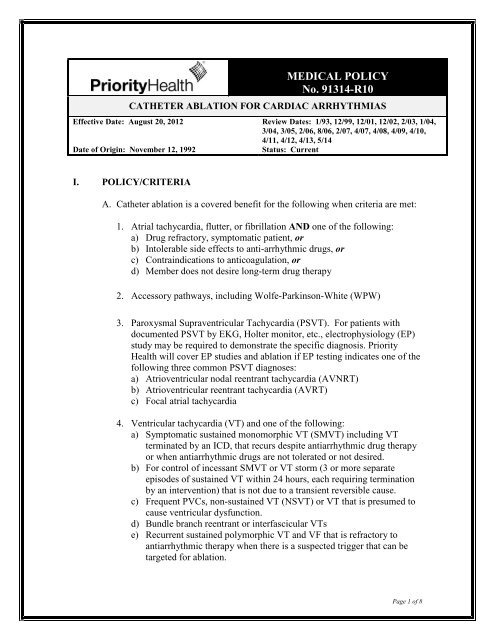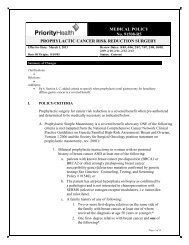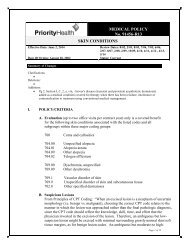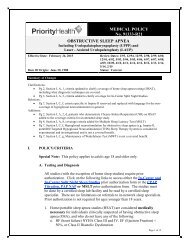Catheter Ablation for Cardiac Arrhythmias - 91314 - Priority Health
Catheter Ablation for Cardiac Arrhythmias - 91314 - Priority Health
Catheter Ablation for Cardiac Arrhythmias - 91314 - Priority Health
Create successful ePaper yourself
Turn your PDF publications into a flip-book with our unique Google optimized e-Paper software.
MEDICAL POLICYNo. <strong>91314</strong>-R10CATHETER ABLATION FOR CARDIAC ARRHYTHMIASEffective Date: August 20, 2012 Review Dates: 1/93, 12/99, 12/01, 12/02, 2/03, 1/04,3/04, 3/05, 2/06, 8/06, 2/07, 4/07, 4/08, 4/09, 4/10,4/11, 4/12, 4/13, 5/14Date of Origin: November 12, 1992Status: CurrentI. POLICY/CRITERIAA. <strong>Catheter</strong> ablation is a covered benefit <strong>for</strong> the following when criteria are met:1. Atrial tachycardia, flutter, or fibrillation AND one of the following:a) Drug refractory, symptomatic patient, orb) Intolerable side effects to anti-arrhythmic drugs, orc) Contraindications to anticoagulation, ord) Member does not desire long-term drug therapy2. Accessory pathways, including Wolfe-Parkinson-White (WPW)3. Paroxysmal Supraventricular Tachycardia (PSVT). For patients withdocumented PSVT by EKG, Holter monitor, etc., electrophysiology (EP)study may be required to demonstrate the specific diagnosis. <strong>Priority</strong><strong>Health</strong> will cover EP studies and ablation if EP testing indicates one of thefollowing three common PSVT diagnoses:a) Atrioventricular nodal reentrant tachycardia (AVNRT)b) Atrioventricular reentrant tachycardia (AVRT)c) Focal atrial tachycardia4. Ventricular tachycardia (VT) and one of the following:a) Symptomatic sustained monomorphic VT (SMVT) including VTterminated by an ICD, that recurs despite antiarrhythmic drug therapyor when antiarrhythmic drugs are not tolerated or not desired.b) For control of incessant SMVT or VT storm (3 or more separateepisodes of sustained VT within 24 hours, each requiring terminationby an intervention) that is not due to a transient reversible cause.c) Frequent PVCs, non-sustained VT (NSVT) or VT that is presumed tocause ventricular dysfunction.d) Bundle branch reentrant or interfascicular VTse) Recurrent sustained polymorphic VT and VF that is refractory toantiarrhythmic therapy when there is a suspected trigger that can betargeted <strong>for</strong> ablation.Page 1 of 8
MEDICAL POLICYNo. <strong>91314</strong>-R10<strong>Catheter</strong> <strong>Ablation</strong> <strong>for</strong><strong>Cardiac</strong> <strong>Arrhythmias</strong>5. <strong>Catheter</strong> ablation of ventricular arrhythmogenic foci is covered after ICDplacement when either of the following conditions is met:a) Failure of ICD defined as ICD-resistant ventricular arrhythmias, orb) Excessively frequent ICD-terminated arrhythmias resistant to reinstitutionof maximal doses of anti-arrhythmic medications.B. High-intensity focused ultrasound (HIFU), (e.g. the Epicor system) as astand-alone ablative procedure <strong>for</strong> atrial fibrillation is consideredinvestigational and is not a covered benefit. The Epicor procedure wasreviewed by <strong>Priority</strong> <strong>Health</strong>’s Technology Assessment Committee in June2006 and this policy reflects the recommendations of the committee.II.MEDICAL NECESSITY REVIEWRequired Not Required Not ApplicableIII.APPLICATION TO PRODUCTSCoverage is subject to member’s specific benefits. Group specific policy willsupersede this policy when applicable. HMO/EPO: This policy applies to insured HMO/EPO plans. POS: This policy applies to insured POS plans. PPO: This policy applies to insured PPO plans. ASO: For self-funded plans, consult individual plan documents. If there is a conflictbetween this policy and a self-funded plan document, the provisions of the plan documentwill govern. INDIVIDUAL: For individual policies, consult the individual insurance policy. If there isa conflict between this medical policy and the individual insurance policy document, theprovisions of the individual insurance policy will govern. MEDICARE: Coverage is determined by the Centers <strong>for</strong> Medicare and Medicaid Services(CMS); if a coverage determination has not been adopted by CMS, this policy applies. MEDICAID: For Medicaid members, this policy will apply. Coverage is based on medicalnecessity criteria being met and the appropriate code(s) from the coding section of thispolicy being included on the Michigan Medicaid Fee Schedule located at:http://www.michigan.gov/mdch/0,1607,7-132-2945_42542_42543_42546_42551-159815--,00.html. If there is a discrepancy between this policy and the Michigan Medicaid ProviderManual located at: http://www.michigan.gov/mdch/0,1607,7-132-2945_5100-87572--,00.html, the Michigan Medicaid Provider Manual will govern. For MedicalSupplies/DME/Prosthetics and Orthotics, please refer to the Michigan Medicaid FeeSchedule to verify coverage. MICHILD: For MICHILD members, this policy will apply unless MICHILD certificate ofcoverage limits or extends coverage.Page 2 of 8
MEDICAL POLICYNo. <strong>91314</strong>-R10<strong>Catheter</strong> <strong>Ablation</strong> <strong>for</strong><strong>Cardiac</strong> <strong>Arrhythmias</strong>IV.DESCRIPTIONAtrial fibrillation (AF) is the most commonly diagnosed cardiac rhythmdisturbance, with an incidence of 0.4% in the general population. AF occurs in ahigh percentage of patients with mitral valve (MV) disease, although it can alsooccur in individuals with no associated cardiac abnormalities. It is characterizedby loss of normal sinoatrial electrical signal and rapid, fine, uncoordinatedcontraction of the atria.Atrial fibrillation is associated with morbidity and mortality despite therapy withcurrent antiarrhythmic drugs. Even the best available medical therapy only yieldsa 50-60 percent annual success rate in maintaining sinus rhythm. Side effects ofthese drugs can be problematic. <strong>Catheter</strong> ablation of arrhythmogenic foci can beper<strong>for</strong>med using radiofrequency, microwave, cryotherapy or ultrasoundtechnology. The Maze (or Cox-Maze) procedure is an open surgical ablativeprocedure <strong>for</strong> atrial fibrillation that can be done alone or in conjunction with valverepair or replacement. High-intensity focused ultrasound (HIFU), the Epicorsystem, may also be used <strong>for</strong> ablation in conjunction with other open heartprocedures.Initial experience with catheter ablation procedures based on a creation of linearlesions in both atria was disappointing but led to the key observation that focaltriggers localized in the pulmonary veins were responsible <strong>for</strong> initiation of atrialfibrillation and are thus suitable targets <strong>for</strong> catheter ablation.Electrical isolation of all four pulmonary veins from the left atrium provides thehighest cure rates <strong>for</strong> atrial fibrillation. However, the procedure is operatordependent and is associated with a small but significant risk of pulmonary veinstenosis. Given the complexity and difficulties in ablating multiple pulmonaryveins, ablation of atrial fibrillation is not considered the initial treatment ofchoice or the standard of care <strong>for</strong> the treatment of atrial fibrillation.The optimal treatment method <strong>for</strong> patients who have idiopathic paroxysmalfibrillation appears to be left atrial catheter ablation as opposed to segmental ostialcatheter ablation. Patients with chronic or persistent atrial fibrillation and patientswith vago-tonic type of paroxysmal atrial fibrillation pulmonary vein isolationhave a low success rate. In these subgroups and in patients with paroxysmal atrialfibrillation that does not respond to pulmonary vein isolation, an approach thatinvolves ablation within the left atrium, it is likely but not proven to yield betterresults.Future Studies:It is expected that with further advances in technology and simplification oftechniques, radio frequency ablation of atrial fibrillation will become aPage 3 of 8
MEDICAL POLICYNo. <strong>91314</strong>-R10<strong>Catheter</strong> <strong>Ablation</strong> <strong>for</strong><strong>Cardiac</strong> <strong>Arrhythmias</strong>widespread procedure. Methods to reduce the risk of pulmonary veins stenosis areunder development. These technological developments primarily focus on designof the catheter tip, including diameter of the catheter tip and method <strong>for</strong> deliveringablative energy. Balloon-based, ultra-sound catheters using laser and cryoablationare currently being designed, as are circular catheters through which eitherradiofrequency or cryo lesions can be delivered.V. CODING INFORMATIONICD-9 Codes that may apply (<strong>for</strong> dates of service on or be<strong>for</strong>e September 30, 2015):426.2 Left bundle branch hemiblock426.3 Other left bundle branch block426.4 Right bundle branch block426.50 – 426.54 Bundle branch block426.7 Anomalous atrioventricular excitation (Wolff Parkinson-White)426.81 Lown-Ganong-Levine syndrome426.89 Other specified conduction disorder427.0 Paroxysmal supraventricular tachycardia427.1 Paroxysmal ventricular tachycardia427.2 Unspecified paroxysmal tachycardia427.31 Atrial fibrillation427.32 Atrial flutter427.41 Ventricular fibrillation427.42 Ventricular flutter427.5 <strong>Cardiac</strong> arrest427.81 Sinoatrial node dysfunction427.89 Other specified cardiac dysrhythmias427.9 <strong>Cardiac</strong> dysrhythmia, unspecified997.1 <strong>Cardiac</strong> complications affecting specified body system, notelsewhere classifiedICD-10 Codes that may apply (<strong>for</strong> dates of service on or after October 1, 2015):I44.30 Unspecified atrioventricular blockI44.39 Other atrioventricular blockI44.4 Left anterior fascicular blockI44.5 Left posterior fascicular blockI44.60 Unspecified fascicular blockI44.69 Other fascicular blockI44.7 Left bundle-branch block, unspecifiedI45.0 Right fascicular blockI45.10 Unspecified right bundle-branch blockI45.19 Other right bundle-branch blockI45.2 Bifascicular blockI45.3 Trifasicular blockI45.4 Nonspecific intraventricular blockPage 4 of 8
MEDICAL POLICYNo. <strong>91314</strong>-R10<strong>Catheter</strong> <strong>Ablation</strong> <strong>for</strong><strong>Cardiac</strong> <strong>Arrhythmias</strong>I45.6 Pre-excitation syndromeI45.89 Other specified conduction disordersI46.2 <strong>Cardiac</strong> arrest due to underlying cardiac conditionI46.9 <strong>Cardiac</strong> arrest, cause unspecifiedI47.0 – I47.9 Paroxysmal tachycardiaI48.0 – I48.92 Atrial fibrillation and flutterI49.01 Ventricular fibrillationI49.02 Ventricular flutterI49.2 Junctional premature depolarizationI49.5 Sick sinus syndrome (Tachycardia-bradycardia syndrome)I49.8 Other specified cardiac arrhythmiasI49.9 <strong>Cardiac</strong> arrhythmia, unspecifiedI51.9 Heart disease, unspecifiedI97.190 – I97.191 Other postprocedural cardiac functional disturbances followingsurgeryI97.790 – I97.791 Other intraoperative cardiac functional disturbances during surgeryR00.1 Bradycardia, unspecifiedCPT/HCPCS Codes93650 Intracardiac catheter ablation of atrioventricular node function,atrioventricular conduction <strong>for</strong> creation of complete heart block, with orwithout temporary pacemaker placement93653 Comprehensive electrophysiologic evaluation including insertion andrepositioning of multiple electrode catheters with induction or attemptedinduction of an arrhythmia with right atrial pacing and recording, rightventricular pacing and recording, His recording with intracardiac catheterablation of arrhythmogenic focus; with treatment of supraventriculartachycardia by ablation of fast or slow atrioventricular pathway, accessoryatrioventricular connection, cavo-tricuspid isthmus or other single atrialfocus or source of atrial re-entry93654 Comprehensive electrophysiologic evaluation including insertion andrepositioning of multiple electrode catheters with induction or attemptedinduction of an arrhythmia with right atrial pacing and recording, rightventricular pacing and recording, His recording with intracardiac catheterablation of arrhythmogenic focus; with treatment of ventricular tachycardiaor focus of ventricular ectopy including intracardiac electrophysiologic 3Dmapping, when per<strong>for</strong>med, and left ventricular pacing and recording, whenper<strong>for</strong>med93656 Comprehensive electrophysiologic evaluation including transseptalcatheterizations, insertion and repositioning of multiple electrode catheterswith induction or attempted induction of an arrhythmia with atrial recordingand pacing, when possible, right ventricular pacing and recording, His bundlePage 5 of 8
MEDICAL POLICYNo. <strong>91314</strong>-R10<strong>Catheter</strong> <strong>Ablation</strong> <strong>for</strong><strong>Cardiac</strong> <strong>Arrhythmias</strong>Maze Procedure <strong>for</strong> Atrial Fibrillation, Hayes Directory Report, March 6, 2003.Updated Search January 24, 2006.Guidant Microwave <strong>Ablation</strong> System, Hayes Search & Summary March 30, 2005Radiofrequency <strong>Ablation</strong> (Isolation) of the Pulmonary Veins <strong>for</strong> the Treatment ofAtrial Fibrillation, Hayes Search & Summary, June 2, 2006.Radiofrequency <strong>Catheter</strong> <strong>Ablation</strong> <strong>for</strong> <strong>Cardiac</strong> <strong>Arrhythmias</strong>, Cigna <strong>Health</strong>careCoverage Position, 4/15/2006. Available on World Wide Web @http://www.cigna.com/health/provider/medical/procedural/coverage_positions/medical/index.html(Retrieved July 10, 2006, March 16, 2009, &February 24, 2010)Microwave <strong>Ablation</strong> <strong>for</strong> Treatment of Atrial Fibrillation, Cigna <strong>Health</strong>careCoverage Position, 11/15/2005. Available on World Wide Web @http://www.cigna.com/health/provider/medical/procedural/coverage_positions/medical/index.html(Retrieved July 10, 2006)Fuster, V. et.al. ACC/AHA/ESC Guidelines <strong>for</strong> the Management of Patients withAtrial Fibrillation. Journal of the American College of Cardiology, Vol.38, No. 4, 2001.Transcatheter <strong>Ablation</strong> of Arrhythmogenic Foci in the Pulmonary Veins as aTreatment of Atrial Fibrillation, The Regence Group Medical Policy,11/01/2005. Available on the World Wide Web @http://www.regence.com/trgmedpol/surgery/sur138.html (Retrieved July12, 2006 & March 16, 2009).Epicor <strong>Cardiac</strong> <strong>Ablation</strong> System <strong>for</strong> the Treatment of Atrial Fibrillation, HayesSearch & Summary, February 15, 2006.Blomström-Lundqvist et al. Management of Patients with Supraventricular<strong>Arrhythmias</strong>J Am Coll Cardiol 2003;42:1493–531 ACC/AHA/ESC Guidelines <strong>for</strong> theManagement of PatientsWith Supraventricular <strong>Arrhythmias</strong> A Report ofthe American College of Cardiology/American Heart Association TaskForce on Practice Guidelines and the European Society ofCardiologyCommittee <strong>for</strong> Practice Guidelines (Writing Committee toDevelop Guidelines <strong>for</strong> the Management of Patients With Supraventricular<strong>Arrhythmias</strong>)Atrial Fibrillation: ACC/AHA/ESC 2006 Guidelines <strong>for</strong> Management of PatientsWith Atrial Fibrillation (J Am Coll Cardiol 2006;48:854-906)Reddy VY, et.al. “Prophylactic catheter ablation <strong>for</strong> the prevention of defibrillatortherapy”, N Engl J Med. 2007 Dec 27;357(26):2657-65.Estes NA, “<strong>Ablation</strong> after ICD implantation--bridging the gap between promiseand practice”, N Engl J Med. 2007 Dec 27;357(26):2717-9.Heart Rhythm. 2009 Jun;6(6):886-933. EHRA/HRS Expert Consensus on<strong>Catheter</strong> <strong>Ablation</strong> of Ventricular <strong>Arrhythmias</strong>: developed in a partnershipwith the European Heart Rhythm Association (EHRA), a RegisteredPage 7 of 8
MEDICAL POLICYNo. <strong>91314</strong>-R10<strong>Catheter</strong> <strong>Ablation</strong> <strong>for</strong><strong>Cardiac</strong> <strong>Arrhythmias</strong>Branch of the European Society of Cardiology (ESC), and the HeartRhythm Society (HRS); in collaboration with the American College ofCardiology (ACC) and the American Heart Association (AHA).Aliot EM, Stevenson WG, Almendral-Garrote JM, Bogun F, Calkins CH,Delacretaz E, Della Bella P, Hindricks G, Jaïs P, Josephson ME, KautznerJ, Kay GN, Kuck KH, Lerman BB, Marchlinski F, Reddy V, Schalij MJ,Schilling R, Soejima K, Wilber D; European Heart Rhythm Association(EHRA); Registered Branch of the European Society of Cardiology(ESC); Heart Rhythm Society (HRS); American College of Cardiology(ACC); American Heart Association (AHA).Wann LS, et. al. Heart Rhythm. 2011 Jan;8(1):157-76. 2011 ACCF/AHA/HRSfocused update on the management of patients with atrial fibrillation(Updating the 2006 Guideline): a report of the American College ofCardiology Foundation/American Heart Association Task Force onPractice Guidelines.High Intensity Focused Ultrasound (HIFU) , Cigna Medical Coverage Policy, @https://cigna<strong>for</strong>hcp.cigna.com/public/content/pdf/coveragePolicies/medical/mm_0274_coveragepositioncriteria_magnetic_res_guided_thermal_ablat_fibroids.pdf (Retrieved April 8, 2014)AMA CPT Copyright Statement:All Current Procedure Terminology (CPT) codes, descriptions, and other data are copyrighted by theAmerican Medical Association.This document is <strong>for</strong> in<strong>for</strong>mational purposes only. It is not an authorization, certification, explanation ofbenefits, or contract. Receipt of benefits is subject to satisfaction of all terms and conditions of coverage.Eligibility and benefit coverage are determined in accordance with the terms of the member’s plan in effectas of the date services are rendered. <strong>Priority</strong> <strong>Health</strong>’s medical policies are developed with the assistanceof medical professionals and are based upon a review of published and unpublished in<strong>for</strong>mation including,but not limited to, current medical literature, guidelines published by public health and health researchagencies, and community medical practices in the treatment and diagnosis of disease. Because medicalpractice, in<strong>for</strong>mation, and technology are constantly changing, <strong>Priority</strong> <strong>Health</strong> reserves the right to reviewand update its medical policies at its discretion.<strong>Priority</strong> <strong>Health</strong>’s medical policies are intended to serve as a resource to the plan. They are not intended tolimit the plan’s ability to interpret plan language as deemed appropriate. Physicians and other providersare solely responsible <strong>for</strong> all aspects of medical care and treatment, including the type, quality, and levelsof care and treatment they choose to provide.The name “<strong>Priority</strong> <strong>Health</strong>” and the term “plan” mean <strong>Priority</strong> <strong>Health</strong>, <strong>Priority</strong> <strong>Health</strong> Managed Benefits,Inc., <strong>Priority</strong> <strong>Health</strong> Insurance Company and <strong>Priority</strong> <strong>Health</strong> Government Programs, Inc.Page 8 of 8
















